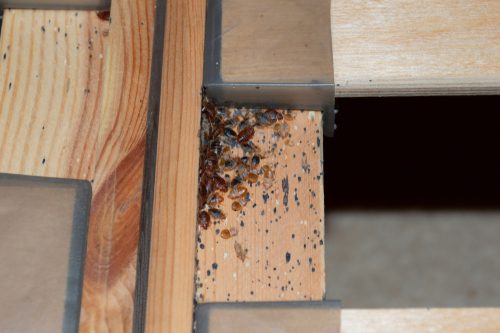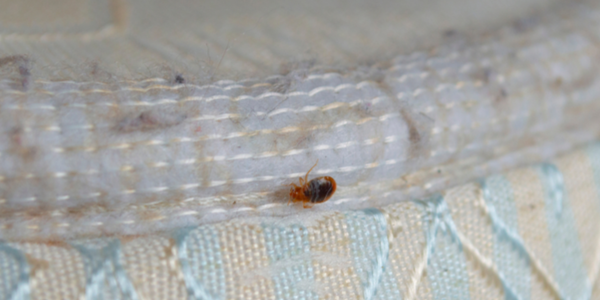Bed bugs are one of the most common and most feared pests in America. And with good reason. Once you have an infestation on your hands (and feet and everywhere else) it can be extremely difficult to get rid of them. That’s where a pest control expert comes in. But how do you know if you have bed bugs?
Itchy bites in the middle of the night are only a part of the picture. To help you determine if you have bed bugs in your home, we’ve outlined the main signs to watch for. We’ve also included some steps for preventing bed bugs so you hopefully never have to worry about them scurrying across your bedroom. If you do have bed bugs, call Gregory Pest Solutions today at (866) 342-8719.
Bed Bug Signs
Want to know how to tell if you have bed bugs? Look for a combination of signs. One alone might not be enough to confirm an infestation, but several can paint a clearer picture. Bed bugs usually stay close to their food source, often the bed itself, but they can spread throughout a room or home over time. Below are some of the most common signs that bed bugs may be present.
Rust Colored Stains
One of the earliest signs people notice is rust colored stains on bed sheets, pillowcases, or the mattress itself. These stains are usually small smears or dots and are often mistaken for something else, like dirt or makeup. In reality, these stains frequently come from crushed bed bugs or digested blood drips after feeding. If you notice blood spots on your sheets and wake up itchy, especially in a line or cluster of bites, it’s worth investigating further.
Musty Odor
Bed bugs often bring with them an unpleasant smell. This is due to a combination of bed bug pheromones, dead bugs and fecal matter. If you notice a musty odor, it may not be that your spouse forgot to shower. Check your mattress. This scent gets stronger when more bugs are present, so it’s often more noticeable in larger infestations.
If the infestation has been ongoing for a while, the smell can linger on bedding, furniture, and clothing. It’s important to note that many other things can cause odor in a room, so this alone isn’t enough to confirm bed bugs. Still, in combination with other signs, it can be helpful.
What Bed Bugs Look Like at Each Life Stage
Knowing what bed bugs look like at different stages of their life can help you spot them more easily. Since they hide during the day, you might not see them crawling around. Instead, you’re more likely to find them while changing sheets, cleaning, or during a close inspection of the mattress and surrounding area.
- Eggs: Bed bug eggs are small and white, about the size of a grain of salt. They’re sticky and are often found in clusters in hidden areas.
- Nymphs (young bed bugs): These are pale or translucent and smaller than adult bed bugs. They’re harder to spot, especially on light-colored fabric.
- Adults: Adult bed bugs are flat and oval-shaped. They’re brownish-red in color and about the size of an apple seed. After feeding, they appear darker and more swollen.
All life stages feed on blood and can hide in tiny cracks and seams. If you see bugs that match these descriptions, there’s a strong chance bed bugs are present.
Bed Bug Shells
As bed bugs grow, they shed their outer layer, which is called an exoskeleton. These shells resemble hollow versions of the bug and are often found near hiding spots such as mattress seams, behind the headboard, or along baseboards.
Shells vary in size depending on the stage the bed bug was in when it molted, but all are a pale yellow or light brown. Finding multiple shells in one area suggests bed bugs have been living and growing there for some time.
You can find these discarded shells in areas where bed bugs hide, such as:
- Under your mattress
- Behind your headboard
- Under carpet or rugs
- Behind molding
- On linens
- In curtain folds
Bed Bug Eggs
Female bed bugs can lay hundreds of eggs during their lifespan. These bed bug eggs are usually laid in tight cracks and crevices, like the seams of mattresses or inside furniture joints. They’re about 1mm long and white.
As they’re so small and usually hidden, most people don’t notice the eggs right away. But if you’re doing a deep clean or inspection and see tiny white specs stuck to surfaces, it could be a warning sign.
Practical Ways to Avoid Bed Bugs
It’s not always possible to prevent bed bugs completely, especially if you live in an apartment building or travel often. However, you can take steps to reduce your chances of bringing them home or spreading them.
When Traveling:
Traveling is the most common way to pick up bed bugs. They thrive in hubs like airports, hotels and bus stations where they can hitchhike on luggage and travelers. To prevent your vacation from turning into an entomology experiment, take the following steps.
- Hotel Check: Strip the bed first and check for rust-colored or black dots. Look for blood spots, bed bug shells, or live bugs around the mattress corners, upholstery, chairs, curtains, and carpet edges. Also, check behind the headboard and in the seams of upholstered furniture.
- Keep bags off the floor: Use luggage racks instead of putting your suitcase on the floor or bed. Bed bugs often crawl into bags left on the floor or under the bed. Some travelers will leave their belongings in the bathroom, where bed bugs are less likely to congregate.
- Pack smart: Store clothing in plastic bags inside your suitcase, and consider using hard-sided luggage rather than soft fabric cases.
- Morning Inspection: Check yourself and the sheets for any telltale signs of bed bugs.
- Inspect Personal Items: Before you leave, inspect your belongings.
- When you return home: unpack directly into a washing machine and run clothes on high heat. Vacuum out your suitcase and inspect it before storing it away.

Places Bed Bugs Hide in Your Home
Bed bugs are skilled at hiding. Their flat bodies allow them to slip into small cracks and dark corners, making them hard to spot during the day.
Common hiding places in the home include:
- Mattress seams and box springs
- Headboards and bed frames
- Inside electrical outlets
- Behind wallpaper or picture frames
- In the seams of couches, chairs, and other furniture
- Under carpets or rugs
Since they prefer to be close to where people sleep, bedrooms are often the first area affected. But if left unchecked, they can spread to other rooms.
Keeping things clean, making regular inspections and taking preventative steps when you travel will help keep bed bugs out of your home. To make sure they don’t slip by, follow these suggestions.
Regular Inspection: Notice any signs of bed bugs around your bed or living areas.
Frequent Vacuuming: Helps in keeping bugs at bay.
Secondhand Precautions: Inspect secondhand clothing or furniture before bringing them inside.
Seal Cracks and Crevices: Around baseboards, windows, and wall outlets to prevent bugs from coming in or out.
Not Sure If You Have Bed Bugs? We’re Here to Help!
If you’ve noticed any of the signs listed above but aren’t quite sure, it’s best not to wait. While DIY methods can temporarily reduce the number of bugs, they often don’t reach deep hiding spots or eliminate eggs. Home remedies may offer short-term relief, but they rarely address the problem at its source.
If you’re seeing signs that make you concerned about bed bugs and need professional inspection, give Gregory Pest Solutions a call today at (866) 342-8719. Our pest control professionals have multiple means of identifying and eliminating bed bugs, helping to protect your home long-term. Don’t wait for things to get worse!
Frequently Asked Questions
Red, itchy bites, rust-colored stains, shed skins, and a musty odor can all be signs of a bed bug problem.
Look for blood spots, molted bed bug shells, and live bugs near beds, furniture, or even electrical outlets.
Baby bed bugs are pale and hard to see, while adults are reddish-brown and about the size of an apple seed.

